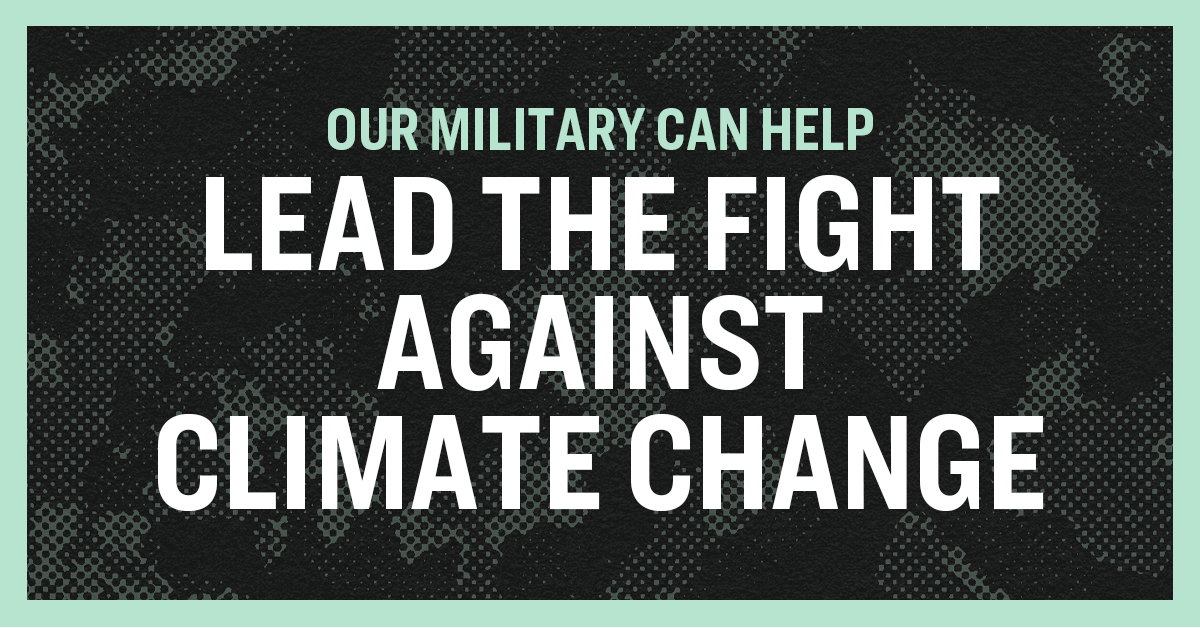
The Pentagon wants to see improvement from
defense contractors in the area of greenhouse gas emissions
Valerie Insinna / Breaking Defense & Aaron Mehta / Breaking Defense
(October 8, 2021) — The Pentagon is preparing to deal with climate change in a more serious way than ever before. (File)
WASHINGTON: A new Pentagon strategy calls for the military services and all defense-related organizations — including contractors — to make changes to mitigate potential vulnerabilities from climate change and reduce emissions.
The 32-page report, released Thursday, states that the Defense Department must adapt to a world where military operations, installations and even weapon systems can all be impacted by climate change.
“Climate change is going to be the context of the world that we live in from now on,” Richard Kidd, the deputy assistant secretary of defense for environment and energy resilience, told reporters during a roundtable on Friday. “No entity can opt out of their responsibilities or requirements to take necessary steps in either adaptation or mitigation.”
The strategy lays out five lines of effort, outlining how the Pentagon can incorporate climate change into its future planning and operations.
Perhaps most notably for the defense industry, the department must harden its supply chains to the effects of climate change, the strategy states. One way it can do that is by leveraging its purchasing power to invest in environmentally-friendly technologies like microgrids and power storage systems that can also improve the survivability of the military.
“To remain agile and flexible in responding to changing conditions, actions will include energy demand reduction to reduce logistics requirements and establish metrics and measures for tracking progress,” the strategy states.
The Pentagon will also seek greater transparency from industry on current levels of greenhouse gas emissions and companies’ plans for reduction.
“Some of our contractors are in fact leaders in this area,” Kidd said. “They have very aggressive greenhouse gas reduction goals and can account for greenhouse gases through most of the steps in the supply chain. But other contractors are not quite there yet. Our goal is to bring all the contractors up to what is best practice.”
The department plans to target places in the supply chain where it can reduce emissions, while also having a positive impact on operations or resiliency, Kidd said. For example, the Defense Department wants to see more domestic production of batteries used in aircraft, on ships or by dismounted troops, which serves a dual purpose of reducing the vulnerability of the US military to supply chain interruptions in the foreign market.
“By bringing that battery manufacturing onshore to the United States, we significantly reduce the carbon impacts while improving the integrity of our supply chain. And that sort of example cascades out through hundreds of items that we buy or purchase,” he said.

The other lines of effort include:
- Ensuring the Department has access to quality data on climate and the environment, and that it creates processes to include that information in the decision-making process, reducing costs and the risk to operations.
- Training troops to withstand extreme weather conditions and making certain that equipment can also function in very hot and cold temperatures.
- Mitigating the risk of floods, wildfires and other natural disasters on military installations by continually assessing the risk to bases and other facilities.
- Enhancing cooperation with partner nations and other US agencies that can increase knowledge about climate change, contribute to resiliency, and reduce costs.
Kidd said it would be difficult to point to specific increases in funding in the upcoming fiscal year 2023 budget that were made as a result of the strategy, because much of the added money is going to “existing investment streams” such as military construction projects or the acquisition of fuel-efficient equipment.
However, there are several areas the department has identified “that could use some significant increases in [funding],” he said. Kidd declined to elaborate on those needs ahead of the FY23 budget.
Existing efforts such as the Energy Resilience and Conservation Investment Program (ERCIP) — a part of the military construction budget that funds projects that contribute to energy efficiency — and the Readiness and Environmental Protection Integration initiative, which helps avoid land-use conflicts with local areas that could inhibit training, could also receive greater attention in future budgets, he said.
Next DoD Budget To Feature Detailed ‘Investments’
To Battle Climate Change
Aaron Mehta / Breaking Defense
“These are not ideological issues of climate versus warfighting,
This is about ensuring we are resilient and capable for the warfighter
of the future, and we’ll be making those investments.”
— Kathleen Hicks, Deputy Secretary of Defense

Deputy Defense Secretary Hicks tours the Nogales Border Patrol
Station Mobile Surveillance Capabilities Site (DoD/Brittany A. Chase)
WASHINGTON: (September 8, 2020) — The Pentagon’s next budget request will feature a more detailed breakdown of its investments on climate-related issues than ever before, with the department’s number two official saying she has put a “special emphasis” on climate solutions.
“These are not ideological issues of climate versus warfighting,” Kathleen Hicks, deputy secretary of defense, said Wednesday. “This is about ensuring we are resilient and capable for the warfighter of the future, and we’ll be making those investments.”
Climate change has been a hot potato for the department for years. While military planners will readily acknowledge concerns about how the climate could impact operations and bases in the future, political partisanship around the climate change issue means tackling it directly has been perilous at times, particularly during the Trump administration.
However, one of the first executive orders by President Joe Biden in January was a government-wide mandate to focus on climate change, which was followed swiftly by guidance from Defense Secretary Lloyd Austin to begin working the issue into department planning processes.
Hicks, who was speaking at the Defense News Conference, said that such work is well underway as the department puts together a strategic review of all its capabilities and global posture. She did not go into details about what might come out of such a review.
Still, it should be easy to get hints from the fiscal 2023 budget, and its associated five-year future spending projection, according to the deputy secretary. “You would see very clearly tagged out in the FY23 budget displays, you’d be able to track much better than the department has in the past, what its spending on climate,” she said.
Hicks also made her case for why the department needs to focus on the climate issue, especially when it is facing flat budgets for the foreseeable future. “Modernizing for the future now really means being resilient on climate,” she said.
In essence, Hicks laid out, there are three broad ways in which the department is being hit with climate change. The first is the amount of money DoD is spending — “billions of dollars in funds every year, just to make up for challenges to our installations, let alone the cost savings that we are not yet accruing when we don’t pursue greener approaches.” Those are dollars that could be going towards modernization efforts instead.
Second are supply chain concerns. She pointed out that as the commercial industry is shifting to greater reliance on green technologies, such as hybrid or purely electric vehicles, DoD could find itself unable to maintain and upkeep its fleets of vehicles if it does not keep up.
And lastly there’s the readiness concern. “We have black flag days” — days where physical training has to be paused due to air quality. “We can’t be ready sufficiently because we can’t fly, we can’t train in certain cases because of wildfires,” Hicks said. Compounding the issue, Hicks said military capabilities and personnel are being forced to assist with domestic climate emergencies like floods and wildfires, rather than preparing for an external threat.
“Those are just some of the areas that we’re really focusing our innovation efforts, and we do think it’s a whole of department approach [that] should pervade everything that we do,” Hicks concluded.
Posted in accordance with Title 17, Section 107, US Code, for noncommercial, educational purposes.